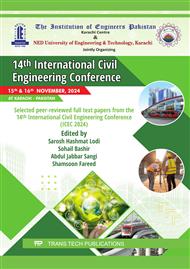p.3
p.11
p.19
p.27
p.43
p.51
p.61
p.73
Investigate the Effect of a Pumice Fine on Strength and Permeability of Pervious Concrete
Abstract:
PC is a type of concrete which is well known for its low strength and high infiltration rate. PC is made up of cement, coarse aggregate, water and with little or no fine, that is the reason PC is also known as no fine concrete. The fine content in PC tends to improve the strength of the concrete yet it adversely affects the infiltration of the PC. Therefore, in this study the pumice stone fine was incorporated in pervious concrete to make a PC with improve strength without sacrificing its infiltration. This experimental investigation helps to explain the effect of pumice stone when used as fine aggregate on the density, void content, compressive strength, flexure strength, and infiltration rate of PC. All PC mixtures were proportioned with a fixed water-to-cement ratio (w/c) of 0.30. The fresh and hardened voids of PC containing pumice fine were up to 9% greater than the PC without fine resulting in about 11% reduction in the hardened density of PC with fine. Moreover, the compressive strength of pervious concrete with incorporation of pumice fine shows a significant increase of about 30% compressive and 40% flexural strength. Moreover, the infiltration rate of PC made with pumice fine showed about 60% improvement. Therefore, pumice fine is a great option for incorporating in PC to improve its overall performance.
Info:
Periodical:
Pages:
11-18
Citation:
Online since:
April 2025
Price:
Сopyright:
© 2025 Trans Tech Publications Ltd. All Rights Reserved
Share:
Citation:


